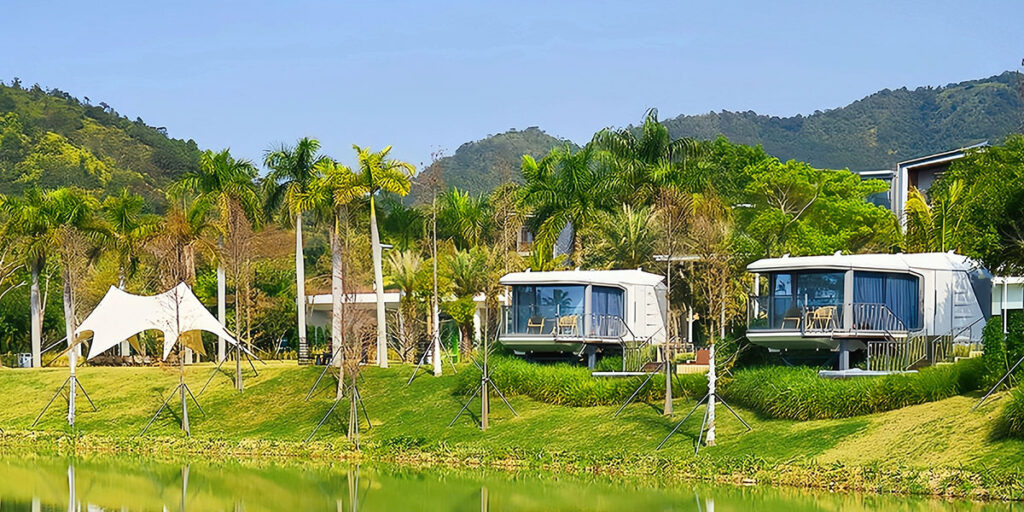
14 Jun Exploring the Eco-Friendly Benefits of Capsule Homes
Table of Contents
Imagine living in a home that’s small and eco-friendly. That’s what a capsule home gives you. Its small size uses less energy daily. This helps the planet and saves resources. These homes are made with materials that can be reused. Building them creates less waste, which protects nature. If you care about the environment or like new ideas, capsule homes are a great choice for green living.
Key Takeaways
Capsule homes are tiny and good for the environment. They use less energy and fewer resources, helping the Earth.
These homes have clever designs to save space and use energy-saving tools like solar panels.
Capsule homes are fast to build and can be changed to fit different needs.
They use recycled and eco-friendly materials, cutting down on waste and pollution.
Capsule homes work well in cities or faraway places. They are cheap and easy to adjust for different lifestyles.
Understanding Capsule Homes
What Is a Capsule Home?
A capsule home is a small, eco-friendly place to live. It’s made to have less impact on the planet. Builders use sustainable materials like recycled steel and old wood. This helps lower carbon emissions. These homes are tiny but have smart features like solar panels and good insulation. You can save money on energy and help the environment at the same time.
Capsule homes focus on being efficient. They use small spaces wisely with neat and useful designs. Whether you need a long-term home or a short-term one, these homes are a modern way to live sustainably.
Unique Features of Capsule Homes
Capsule homes have cool features that make them stand out. Here’s what makes them unique:
Space Efficiency: Every part of the home is useful. Smart furniture and storage make small areas feel bigger.
Quick Installation: These homes are built fast, often in just days.
Eco-Friendly Materials: Lightweight, recyclable materials like aluminum reduce waste.
Smart Technology: Built-in systems save energy and keep the home comfy.
Customizable Design: You can change the look with different styles and roofs.
Tip: If you like flexibility, capsule homes let you change their size and layout to fit your needs.
How Capsule Homes Stand Out from Traditional Housing
Capsule homes are very different from regular houses. Their small size means they use fewer materials and less energy. Regular houses often need more resources and energy over time.
Another big difference is how fast they’re built. Regular houses take months, but capsule homes are ready in days. They can also be moved if you need to relocate. Plus, their modern designs make them both stylish and practical.
If you want a green and flexible home, a capsule home could be perfect for you.
Environmental Advantages of Capsule Homes

Energy Efficiency and Renewable Energy Integration
Capsule homes are built to save energy. They use less power to keep you comfortable. Many have solar panels and strong insulation. Solar panels use sunlight to make electricity. This lowers the need for regular power sources. Insulation keeps the inside temperature steady. You won’t need heaters or air conditioners as much. This saves energy and cuts down your bills.
Capsule homes also have energy-saving appliances. These use less electricity but work well. Examples include LED lights and smart thermostats. They help you manage energy without extra effort. Living in a capsule home is good for your wallet and the planet.
Did you know? Solar power can greatly lower your carbon footprint over time.
Reduced Construction Waste and Carbon Footprint
Capsule homes create less waste during building. They are prefabricated, meaning parts are made in factories and put together later. This process uses fewer materials and avoids waste. Regular building often leaves piles of unused wood and concrete. Capsule homes skip this problem.
Their small size means fewer resources are needed to build them. This lowers the carbon footprint of construction. Moving prefabricated parts uses less fuel than transporting heavy equipment. Capsule homes are a smart choice for eco-friendly living.
Use of Recycled and Sustainable Materials
Capsule homes use recycled and sustainable materials to help the planet. Builders use recycled steel, old wood, and aluminum. These materials cut waste and make homes strong. Factory-made parts ensure resources are used wisely, leaving little waste.
Some homes use natural materials like cane fibers and coconut tow. These replace harmful options like fiberglass. This makes the homes even greener. Choosing a capsule home supports eco-friendly practices and sustainability.
Tip: Pick capsule homes with natural insulation. It’s better for the planet and saves energy.
Adaptability and Cost-Effectiveness of Capsule Homes
Modular Design for Diverse Applications
Capsule homes use a modular design, making them very flexible. You can use them as small homes or workspaces. Adding or removing sections is simple. Need more space? Add a module. Want a smaller area? Take one away. This makes it easy to change your home without big renovations.
These homes work well in special places too. They’re great for eco-tourism, emergency shelters, or pop-up shops. Their design allows quick setup and takedown, perfect for short-term use. Whether in a busy city or quiet countryside, they can match the surroundings.
Fun Fact: Modular designs are like adult Legos. Build your own unique space!
Affordable Construction and Maintenance
Capsule homes are built to save money over time. They use strong materials like aluminum and steel that last long. These materials need little fixing, saving on repairs. Energy-saving features like insulation and solar panels cut heating and cooling costs.
Here’s how they compare to regular homes:
They use 65% less energy, lowering bills.
Lightweight materials mean less time and money for upkeep.
While they may cost more upfront, they save money later.
Capsule homes are a smart choice for saving money and helping the planet. You’ll spend less while living sustainably.
Tip: Look for capsule homes with energy-saving features. They save money over time!
Suitability for Urban and Remote Areas
Capsule homes fit well in cities and remote areas. In cities, they solve space and cost problems. Their small size works on tiny plots, and their modern look fits city life. Over 60% of urban buyers choose them for their low cost and flexibility.
In remote areas, they’re easy to move and set up. This makes them great for off-grid living or eco-tourism. Energy-efficient systems keep them comfy even far from cities. Whether you want a city home or a rural retreat, capsule homes work for both.
Here’s a table showing how capsule homes perform in different markets:
Market Type | Adoption Rate | Key Factors |
|---|---|---|
Urban | Over 60% | High demand for affordable lodging, space constraints, cultural acceptance |
Non-Urban | About 25% | Cultural perceptions of hospitality, preference for larger accommodations |
Millennials | 40% prioritize unique experiences | Budget-friendly options, rising housing costs, adaptability of younger generations |
Capsule homes show that being eco-friendly and flexible works anywhere you live.
Real-World Examples of Capsule Homes
Capsule Homes in Eco-Tourism
Capsule homes are becoming popular in eco-tourism. Picture staying in a small, eco-friendly pod surrounded by nature. These homes are great for glamping and eco-lodges. Their tiny size fits into nature without causing harm. You can find them in forests, deserts, or near beaches. They let you enjoy nature while protecting it.
Many eco-tourism places use capsule homes because they’re simple to set up. They don’t need big construction, so the land stays untouched. Their energy-saving features, like solar panels, make them perfect for off-grid spots. If you care about eco-friendly travel, these homes are a great choice.
Fun Fact: Some capsule homes in eco-tourism look like treehouses or igloos!
Emergency and Disaster Relief Housing
Capsule homes are very helpful during emergencies. When disasters happen, people need quick shelter. These homes can be moved and built fast, giving instant help. Their design allows easy changes for uses like medical care or family housing.
Governments and aid groups like capsule homes because they’re strong and affordable. They can handle bad weather and keep people safe. You’ll see them used after floods, earthquakes, or hurricanes. Their small size makes them easy to store and use again later.
Tip: Capsule homes can be reused for future emergencies, saving money and resources.
Off-Grid Living and Remote Workspaces
Capsule homes are ideal for off-grid living and remote work. If you want to leave the city, these homes make it easy. They have features like solar panels, rainwater systems, and composting toilets. You can live comfortably without city utilities.
For remote workers, capsule homes provide a quiet space to focus. You can place one in your yard or a peaceful area. Their modular design lets you add more space if needed. Whether for work or relaxation, these homes fit your lifestyle.
Did you know? Some capsule homes are fully self-sufficient, perfect for remote areas.
Capsule homes are a clever choice for sustainable living. They cut down waste, save power, and use green materials. Their small size makes them budget-friendly and easy to adjust. Whether you live in a city or far away, they work well. As more people go green, capsule homes might shape a brighter future. Why not try this creative housing idea yourself?
Note: Tiny lifestyle changes can greatly help the Earth.
FAQ
What is the average cost of a capsule home?
Capsule homes cost between $20,000 and $50,000. Prices depend on size and materials. Features also affect the cost. Though they seem pricey, they save money later. Energy bills and repairs are much lower over time.
Can capsule homes be moved to a new location?
Yes, capsule homes can be moved easily! They are lightweight and portable. You can relocate them to cities or remote areas. Just pack it up and move. They fit your lifestyle wherever you go. 🚚
Are capsule homes safe during extreme weather?
Capsule homes are strong and safe in bad weather. Builders use tough materials like steel and aluminum. Some models have extra weatherproofing. They protect you from rain, snow, and wind.
How long does it take to build a capsule home?
Capsule homes are built very fast. Most are ready in days or weeks. Prefabricated parts make construction quicker. You won’t wait months like with regular houses.
Can capsule homes be customized?
Yes, you can design your capsule home! Choose layouts, colors, and features. Add solar panels or eco-friendly materials. Change the roof style too. Make it your own unique space! 🌟



